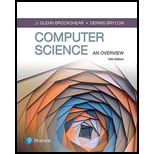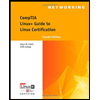
Computer Science: An Overview (13th Edition) (What's New in Computer Science)
13th Edition
ISBN: 9780134875583
Author: BROOKSHEAR
Publisher: PEARSON
expand_more
expand_more
format_list_bulleted
Concept explainers
Question
Chapter 10.4, Problem 2QE
Program Plan Intro
Clipping:
A clipping is the process of deleting the parts of an object or objects which do not lie in the visual volume.
Scan conversion:
A scan conversion is the process in which pixel positions are associated with the points in the scene.
Expert Solution & Answer
Want to see the full answer?
Check out a sample textbook solution
Students have asked these similar questions
Information Security Risk and Vulnerability Assessment
1- Which TCP/IP protocol is used to convert the IP address to the Mac address? Explain 2-What popular switch feature allows you to create communication boundaries between systems connected to the switch3- what types of vulnerability directly related to the programmer of the software?4- Who ensures the entity implements appropriate security controls to protect an asset?
Please do not use AI and add refrence
Find the voltage V0 across the 4K resistor using the mesh method or nodal analysis. Note: I have already simulated it and the value it should give is -1.714V
Resolver por superposicion
Chapter 10 Solutions
Computer Science: An Overview (13th Edition) (What's New in Computer Science)
Ch. 10.1 - Prob. 1QECh. 10.1 - Prob. 2QECh. 10.1 - Prob. 3QECh. 10.2 - Prob. 1QECh. 10.2 - Prob. 2QECh. 10.2 - Prob. 3QECh. 10.3 - Prob. 1QECh. 10.3 - Prob. 2QECh. 10.3 - Prob. 3QECh. 10.3 - Prob. 4QE
Ch. 10.3 - Prob. 5QECh. 10.4 - Prob. 1QECh. 10.4 - Prob. 2QECh. 10.4 - Prob. 3QECh. 10.4 - Prob. 4QECh. 10.4 - Prob. 5QECh. 10.5 - Prob. 1QECh. 10.5 - Prob. 2QECh. 10.5 - Prob. 3QECh. 10.5 - Prob. 4QECh. 10.6 - Prob. 1QECh. 10.6 - What is a storyboard?Ch. 10.6 - Prob. 3QECh. 10.6 - Prob. 4QECh. 10 - Prob. 1CRPCh. 10 - Prob. 2CRPCh. 10 - Prob. 3CRPCh. 10 - Prob. 4CRPCh. 10 - Prob. 5CRPCh. 10 - Prob. 6CRPCh. 10 - Prob. 7CRPCh. 10 - Prob. 8CRPCh. 10 - Prob. 9CRPCh. 10 - Prob. 10CRPCh. 10 - Prob. 11CRPCh. 10 - Prob. 12CRPCh. 10 - Prob. 13CRPCh. 10 - Prob. 14CRPCh. 10 - Prob. 15CRPCh. 10 - Prob. 16CRPCh. 10 - Prob. 17CRPCh. 10 - Prob. 18CRPCh. 10 - Prob. 19CRPCh. 10 - Prob. 20CRPCh. 10 - Prob. 21CRPCh. 10 - Prob. 22CRPCh. 10 - Prob. 23CRPCh. 10 - Prob. 24CRPCh. 10 - Prob. 25CRPCh. 10 - Prob. 26CRPCh. 10 - Prob. 27CRPCh. 10 - Prob. 28CRPCh. 10 - Prob. 29CRPCh. 10 - Prob. 30CRPCh. 10 - Prob. 31CRPCh. 10 - Prob. 32CRPCh. 10 - Prob. 33CRPCh. 10 - In what way does the hardware in a computer...Ch. 10 - Prob. 35CRPCh. 10 - Prob. 36CRPCh. 10 - Prob. 37CRPCh. 10 - Prob. 38CRPCh. 10 - Prob. 39CRPCh. 10 - Prob. 40CRPCh. 10 - Prob. 41CRPCh. 10 - Prob. 42CRPCh. 10 - Prob. 43CRPCh. 10 - Prob. 44CRPCh. 10 - Prob. 1SICh. 10 - The following questions are intended as a guide to...Ch. 10 - Prob. 3SICh. 10 - Prob. 4SI
Knowledge Booster
Learn more about
Need a deep-dive on the concept behind this application? Look no further. Learn more about this topic, computer-science and related others by exploring similar questions and additional content below.Similar questions
- Describe three (3) Multiplexing techniques common for fiber optic linksarrow_forwardCould you help me to know features of the following concepts: - commercial CA - memory integrity - WMI filterarrow_forwardBriefly describe the issues involved in using ATM technology in Local Area Networksarrow_forward
- For this question you will perform two levels of quicksort on an array containing these numbers: 59 41 61 73 43 57 50 13 96 88 42 77 27 95 32 89 In the first blank, enter the array contents after the top level partition. In the second blank, enter the array contents after one more partition of the left-hand subarray resulting from the first partition. In the third blank, enter the array contents after one more partition of the right-hand subarray resulting from the first partition. Print the numbers with a single space between them. Use the algorithm we covered in class, in which the first element of the subarray is the partition value. Question 1 options: Blank # 1 Blank # 2 Blank # 3arrow_forward1. Transform the E-R diagram into a set of relations. Country_of Agent ID Agent H Holds Is_Reponsible_for Consignment Number $ Value May Contain Consignment Transports Container Destination Ф R Goes Off Container Number Size Vessel Voyage Registry Vessel ID Voyage_ID Tonnagearrow_forwardI want to solve 13.2 using matlab please helparrow_forward
- a) Show a possible trace of the OSPF algorithm for computing the routing table in Router 2 forthis network.b) Show the messages used by RIP to compute routing tables.arrow_forwardusing r language to answer question 4 Question 4: Obtain a 95% standard normal bootstrap confidence interval, a 95% basic bootstrap confidence interval, and a percentile confidence interval for the ρb12 in Question 3.arrow_forwardusing r language to answer question 4. Question 4: Obtain a 95% standard normal bootstrap confidence interval, a 95% basic bootstrap confidence interval, and a percentile confidence interval for the ρb12 in Question 3.arrow_forward
arrow_back_ios
SEE MORE QUESTIONS
arrow_forward_ios
Recommended textbooks for you
 Enhanced Discovering Computers 2017 (Shelly Cashm...Computer ScienceISBN:9781305657458Author:Misty E. Vermaat, Susan L. Sebok, Steven M. Freund, Mark Frydenberg, Jennifer T. CampbellPublisher:Cengage Learning
Enhanced Discovering Computers 2017 (Shelly Cashm...Computer ScienceISBN:9781305657458Author:Misty E. Vermaat, Susan L. Sebok, Steven M. Freund, Mark Frydenberg, Jennifer T. CampbellPublisher:Cengage Learning Fundamentals of Information SystemsComputer ScienceISBN:9781305082168Author:Ralph Stair, George ReynoldsPublisher:Cengage Learning
Fundamentals of Information SystemsComputer ScienceISBN:9781305082168Author:Ralph Stair, George ReynoldsPublisher:Cengage Learning Principles of Information Systems (MindTap Course...Computer ScienceISBN:9781285867168Author:Ralph Stair, George ReynoldsPublisher:Cengage Learning
Principles of Information Systems (MindTap Course...Computer ScienceISBN:9781285867168Author:Ralph Stair, George ReynoldsPublisher:Cengage Learning Systems ArchitectureComputer ScienceISBN:9781305080195Author:Stephen D. BurdPublisher:Cengage Learning
Systems ArchitectureComputer ScienceISBN:9781305080195Author:Stephen D. BurdPublisher:Cengage Learning CompTIA Linux+ Guide to Linux Certification (Mind...Computer ScienceISBN:9781305107168Author:Jason EckertPublisher:Cengage Learning
CompTIA Linux+ Guide to Linux Certification (Mind...Computer ScienceISBN:9781305107168Author:Jason EckertPublisher:Cengage Learning

Enhanced Discovering Computers 2017 (Shelly Cashm...
Computer Science
ISBN:9781305657458
Author:Misty E. Vermaat, Susan L. Sebok, Steven M. Freund, Mark Frydenberg, Jennifer T. Campbell
Publisher:Cengage Learning

Fundamentals of Information Systems
Computer Science
ISBN:9781305082168
Author:Ralph Stair, George Reynolds
Publisher:Cengage Learning

Principles of Information Systems (MindTap Course...
Computer Science
ISBN:9781285867168
Author:Ralph Stair, George Reynolds
Publisher:Cengage Learning

Systems Architecture
Computer Science
ISBN:9781305080195
Author:Stephen D. Burd
Publisher:Cengage Learning


CompTIA Linux+ Guide to Linux Certification (Mind...
Computer Science
ISBN:9781305107168
Author:Jason Eckert
Publisher:Cengage Learning